
Are Low Bed Heights Good?
📋 KEY TAKEAWAYS
| Benefit | Standard Beds | Low-Height Beds |
|---|---|---|
| Fall Risk | Higher injury potential (22"+ height) | Reduced injury risk (7"-15" height) |
| Transfer Safety | Challenging for limited mobility | Easier, safer transfers |
| Independence | Often requires assistance | Promotes self-sufficiency |
| Caregiver Access | Good (if fixed height) | Poor (if fixed low height) |
| Ideal Solution | Standard height beds | Hi-Lo adjustable beds |
Best Overall: Ultra Low Hospital Bed Medacure ULB3.9 – Ultra-low 3.9" height for maximum fall protection
Budget Option: Costcare Ultra Low Hospital Bed B437 – Affordable low-profile design at $1,857
For Both Safety & Care: Medacure Ultra Low Hospital Bed ULB7/30-CLS – 7"-30" range with locking system
The Answer is Low bed heights are excellent for fall prevention and injury reduction in vulnerable populations.
Hospital beds with low height capabilities (7"-15" from floor to mattress top) significantly reduce fall injury severity and provide safer, more independent transfers for elderly and limited mobility individuals.
The optimal solution combines low heights with adjustability, as found in height-adjustable hospital beds that can lower for safety and raise for caregiver access.
While standard beds sit 22"-30" from the floor, specially designed ultra-low hospital beds can descend to as little as 3.9" from the floor, creating a dramatically safer sleep environment. This article explores the advantages and limitations of low bed heights and identifies when they're most beneficial for home and clinical care.
Benefits of Low Bed Heights for Safety
Low bed heights provide significant safety advantages for vulnerable individuals, particularly those at risk of falls.
Fall Injury Prevention
The most compelling benefit of low bed heights is the significant reduction in fall-related injuries:
- Physics of falls: Injury severity directly correlates with fall height
- Impact reduction: Falls from 7"-10" heights dramatically reduce impact force compared to standard 22"-30" beds
- Fracture prevention: Hip and wrist fractures—common in elderly falls—are less likely from lower heights
- Head injury reduction: Critical head injuries are minimized with near-floor positioning
- Soft tissue protection: Bruising and soft tissue damage decreases with reduced fall distances
The Low Profile Hospital Bed Prius Descend Ultra exemplifies this safety approach with its ultra-low height capability for $2,450.
Transfer Safety Improvement
| Transfer Benefit | Standard Height (22"-30") | Low Height (7"-15") |
|---|---|---|
| Foot Placement | Feet may dangle, causing instability | Feet can firmly contact floor |
| Balance Control | Challenging for those with balance issues | Better stability during transitions |
| Stand-to-Sit | Requires lowering further, risk of "plopping" | Smaller distance to navigate |
| Caregiver Assistance | Often requires substantial help | May enable independent transfers |
| Night Transfers | Higher risk during drowsy states | Safer transitions when half-awake |
Low bed heights significantly improve transfer safety by:
- Reducing distance: Minimizing the vertical distance traveled during transfers
- Enabling foot placement: Allowing feet to firmly contact the floor before standing
- Improving leverage: Providing better mechanical advantage for standing and sitting
- Enhancing stability: Creating more stable transitions with better balance control
- Reducing momentum: Decreasing the "dropping" or "plopping" effect during sitting
Independence Promotion
Low bed heights can significantly increase independence for many individuals:
- Self-transfers: Enable independent bed entry/exit for many who would otherwise need assistance
- Confidence building: Reduce fear of falls, encouraging more movement
- Psychological benefits: Promote dignity and self-sufficiency
- Reduced call bells: Decrease dependency on caregivers for basic mobility
- Activity promotion: Encourage more frequent position changes and movement
The Costcare Ultra Low Hospital Bed B437 promotes independence with its low-profile design while maintaining essential medical features at $1,857.
Limitations and Challenges of Low Bed Heights
While low bed heights offer significant advantages, they also present certain limitations that must be considered.
Caregiver Ergonomic Challenges
Fixed low bed heights can create significant problems for caregivers:
- Back strain: Bending to provide care at extremely low heights causes caregiver injury
- Care quality: May compromise thorough care delivery due to awkward positions
- Task limitations: Makes certain procedures more difficult or impossible
- Fatigue increase: Accelerates caregiver fatigue and burnout
- Time factor: Slows care delivery, reducing efficiency
The solution to this challenge is height-adjustable or Hi-Lo beds like the Adjustable Hospital Bed Medecure ULB48-X-7/30-CLS, which provides a 7"-30" height range, accommodating both patient safety and caregiver ergonomics for $1,950.
Specific User Limitations
Low beds are not ideal for all users and situations:
| User Type | Low Bed Challenges | Better Alternative |
|---|---|---|
| Joint Replacement Patients | Too low for safe hip/knee protocols | Standard height or adjustable |
| Severe Respiratory Conditions | Can worsen breathing difficulties | Elevated head positioning |
| Wheelchair Users | Height mismatch with wheelchair | Height-matched transfers |
| Very Tall Individuals | Greater distance to stand | Mid-height adjustable |
| Bariatric Patients | May have difficulty rising from very low heights | Bariatric adjustable beds |
Specific populations may experience challenges with fixed low beds:
- Joint replacement patients: May violate hip precautions and knee protocols
- Respiratory patients: Can create challenges for optimal breathing positions
- Wheelchair transfers: Create height discrepancies with wheelchair seats
- Very tall individuals: Increase the distance needed to stand fully upright
- Bariatric patients: May have difficulty rising from extremely low positions
Environmental Considerations
The physical environment impacts the practicality of low beds:
- Floor conditions: Require clean, clear flooring around the bed
- Temperature concerns: Proximity to floor can be colder and draftier
- Pest considerations: Closer exposure to floor-level pests in some environments
- Cleaning challenges: More difficult access under the bed for cleaning
- Visibility issues: May be harder to see at very low heights
These environmental factors highlight why adjustable height-variable beds like the Icare High Low Hospital Bed IC222 provide the most versatile solution, starting at $2,800.
Ideal Heights for Different Populations
The optimal bed height varies significantly based on the individual's characteristics and needs.
Elderly and Fall Risk Individuals
For elderly individuals with high fall risk, the ideal heights are:
- Optimal safety height: 7"-10" from floor to mattress top
- Ultra-low for severe risk: 3"-5" for maximum fall protection
- Transfer consideration: Matched to individual's lower leg length when seated
- Cognitive factors: Lower heights for those with dementia or confusion
- Balance issues: Lower heights correlate with balance impairment severity
The Ultra Low Hospital Bed Medacure ULB3.9 provides an industry-leading low height of just 3.9" from the floor, maximizing fall protection for high-risk elderly individuals.
Recovery and Rehabilitation Patients
For those recovering from surgery or injury, height considerations include:
| Recovery Scenario | Ideal Bed Height | Rationale |
|---|---|---|
| Hip Replacement | 18"-22" | Maintains hip precautions |
| Knee Surgery | 18"-20" | Supports proper leg alignment |
| Stroke Recovery | 14"-18" with adjustment | Balance between safety and function |
| Spinal Procedures | Variable (adjustable) | Changing needs through recovery |
| General Weakness | 15"-18" | Supports independence with safety |
- Orthopedic considerations: Height must accommodate surgical protocols
- Therapeutic goals: Support therapy and recovery activities
- Progressive adjustment: Need for changing heights as recovery progresses
- Equipment integration: Accommodate walkers, canes, and other assistive devices
- Independence promotion: Balance safety with rehabilitation goals
Caregiver Perspectives
For optimal caregiver ergonomics, different bed heights are required:
- Optimal working height: 25"-30" from floor to mattress top
- Task-specific adjustments: Different heights for different care activities
- Caregiver physical factors: Taller caregivers need higher working heights
- Care duration: More frequent or longer care requires optimal ergonomics
- Procedure complexity: More complex care necessitates better positioning
The Medacure Ultra Low Hospital Bed ULB7/30-CLS provides an excellent range from 7" (patient safety) to 30" (caregiver ergonomics) with a locking system for $1,741.
Hi-Lo Adjustable Beds: The Optimal Solution
For most situations, height-adjustable beds provide the best balance of safety and functionality.
The Versatility Advantage
Height-adjustable beds offer significant advantages over fixed-height options:
- Dual optimization: Can be both ultra-low for safety and elevated for care
- Customization: Adjust to individual user height and preference
- Adaptability: Accommodate changing medical conditions and needs
- Multiple users: Suitable for various caregivers of different heights
- Progressive care: Support rehabilitation with changing height requirements
Premium options in the Hi-Lo hospital bed category like the TransferMaster Full Electric Hi-Lo Hospital Bed provide maximum versatility.
Safety Without Compromise
Height-adjustable beds achieve safety goals without sacrificing other important factors:
| Need | Fixed Low Bed | Fixed Standard Bed | Hi-Lo Adjustable Bed |
|---|---|---|---|
| Fall Safety | Excellent | Poor | Excellent (when lowered) |
| Transfer Safety | Good | Fair | Excellent (customizable) |
| Caregiver Access | Poor | Good | Excellent (when raised) |
| Procedure Support | Limited | Good | Excellent (adjustable) |
| Adaptability | Poor | Poor | Excellent |
- Night safety: Can be lowered during sleep for maximum fall protection
- Morning transfers: Adjusted to optimal transfer height for breakfast
- Care delivery: Raised for caregiver access during bathing and treatment
- Visitor interaction: Positioned at social heights during family visits
- Medical procedures: Precisely positioned for specific interventions
Cost-Benefit Analysis
The investment in height-adjustable beds typically provides superior value:
- Fall prevention savings: Reduced medical costs from avoided injuries
- Caregiver health: Lower healthcare and lost-time costs for caregivers
- Extended independence: Delayed need for higher levels of care
- Adaptability value: Single solution for changing needs over time
- Long-term use: Suitable throughout progressive conditions
Premium options like the Icare Adjustable Electric Home Hospital Bed - IC333 at $3,200 provide superior versatility and value over time.
Practical Implementation of Low Bed Heights
Successfully implementing low bed heights requires attention to several practical considerations.
Complementary Safety Measures
Low beds work best as part of a comprehensive safety system:
- Floor mats: Impact-absorbing mats alongside ultra-low beds
- Motion sensors: Bed exit and movement notification systems
- Proper lighting: Clear visibility for nighttime transitions
- Grab bars: Strategic placement of support handles
- Clear pathways: Unobstructed routes to bathroom and common areas
Proper Measurement and Fitting
To determine the ideal bed height for an individual:
- Lower leg measurement: Measure from floor to back of knee when seated
- Transfer technique: Consider the specific transfer methods used
- Assistive devices: Account for walkers, canes, or other mobility aids
- User preference: Incorporate comfort and confidence factors
- Caregiver input: Consider the needs of those providing assistance Models like the Emerald Hospital Adjustable Bed Oasis 52200 offer customizable height options to meet individual needs for $1,940.
Training and Education
For maximum benefit from low bed heights, proper education is essential:
- User training: Instructions on safe transfers and position changes
- Caregiver education: Proper assistance techniques and height adjustment
- Height management: Guidelines for when to adjust heights for different activities
- Risk assessment: Ongoing evaluation of fall risk and height needs
- Regular reassessment: Modifications as conditions change over time
Our Top Recommendation for Low Bed Heights
After examining various options across safety, functionality, and adaptability metrics, the Ultra Low Hospital Bed Medacure ULB3.9 emerges as our top recommendation for low bed height needs.
This premium height-adjustable bed offers:
- Industry-leading low height: 3.9" minimum height for maximum fall protection
- Full electric functionality: Easy adjustment of all positions
- Solid construction: Medical-grade durability for long-term use
- Fall prevention focus: Designed specifically for high-risk individuals
- Caregiver-friendly features: Height range accommodates care delivery
For those with budget constraints, the Costcare Ultra Low Hospital Bed B437 offers excellent low-height functionality at $1,857.
For the optimal balance of patient safety and caregiver access, the Medacure Ultra Low Hospital Bed ULB7/30-CLS provides a versatile 7"-30" height range with a locking system for $1,741.
Frequently Asked Questions
What is considered a "low" bed height for fall prevention?
Beds below 15" from floor to mattress top are considered low, with 7"-10" being optimal and ultra-low beds reaching 3"-5" for maximum fall protection.
Do low beds work without side rails for elderly users?
Low beds reduce fall injury risk but should still use side rails for complete protection, especially for confused or restless elderly individuals.
Can Medicare cover adjustable-height hospital beds?
Yes, Medicare typically covers 80% of approved height-adjustable hospital beds when prescribed by a physician as medically necessary for safety or care.
Are ultra-low beds suitable for all elderly individuals?
No. While excellent for fall risks, ultra-low beds aren't ideal for those with joint replacements, severe respiratory issues, or who use wheelchairs for transfers.
What's the best bed height for someone after hip replacement?
Higher beds (18"-22") are better for hip replacement recovery to maintain proper hip precautions and prevent excessive hip flexion during transfers.
How do caregivers work with low-height beds?
Caregivers should use height-adjustable beds, raising them to 25"-30" for care tasks and lowering them for safety when supervision isn't available.
Are there portable options for creating a low bed height?
Yes, bed height reducers and adjustable leg systems can temporarily lower standard beds, though purpose-built adjustable beds offer better functionality.












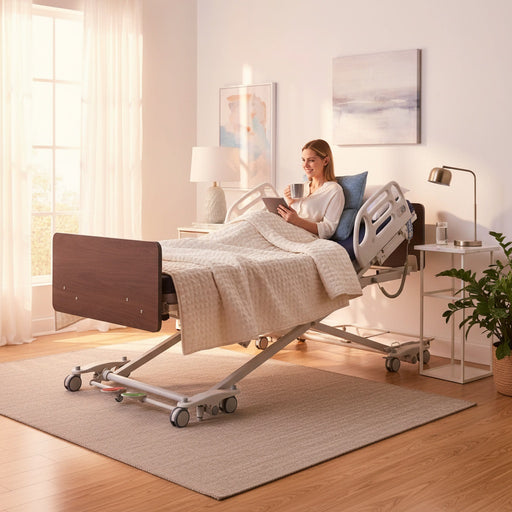
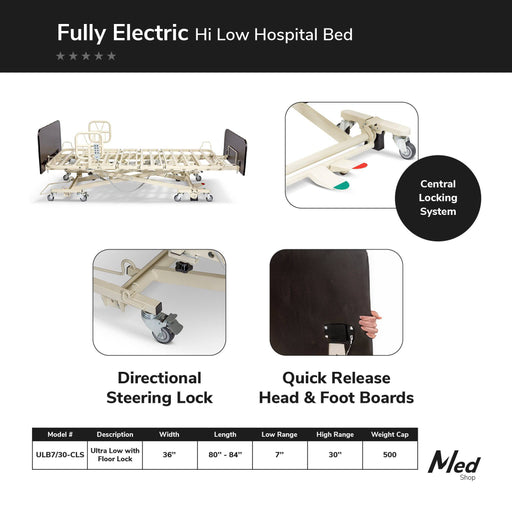
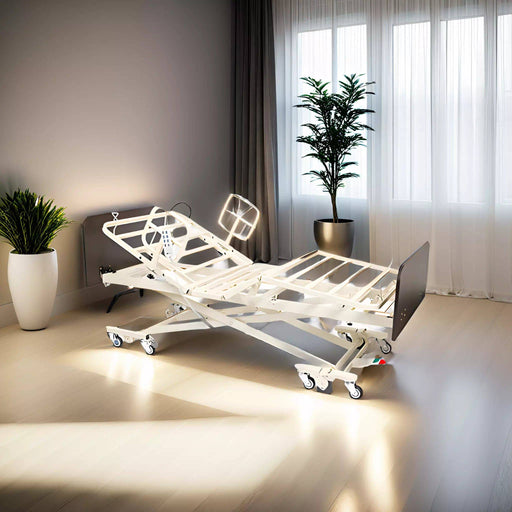


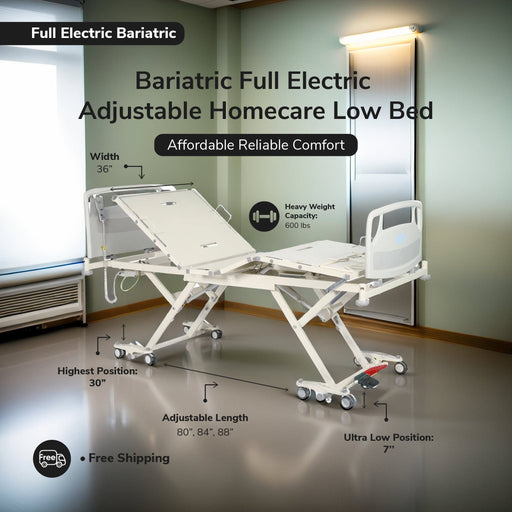
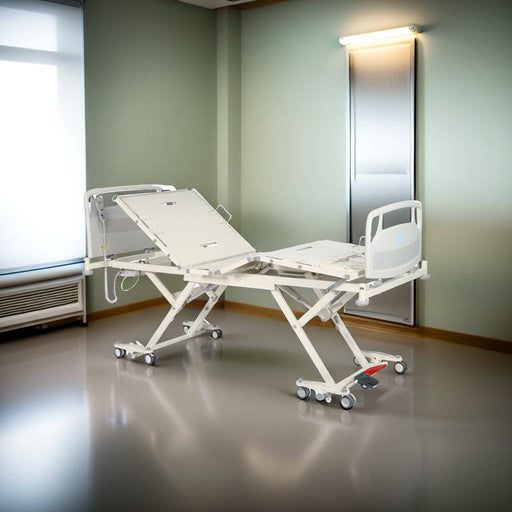
Leave a comment